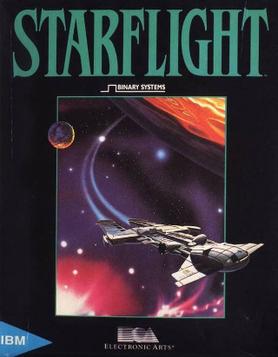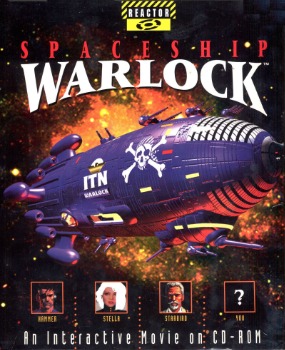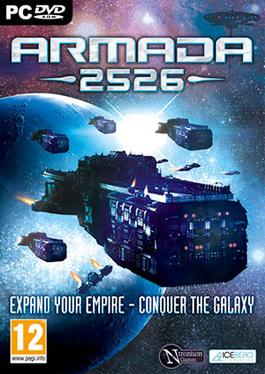
The Ringworld science fiction role-playing game was published by Chaosium in 1984, using the Basic Role-Playing system for its rules and Larry Niven's Ringworld novels as a setting.

Star Frontiers is a science fiction role-playing game produced by TSR from 1982 to 1985. The game offers a space opera action-adventure setting.

Star Control II: The Ur-Quan Masters is a 1992 video game, the sequel to Star Control. It was developed by Toys for Bob and originally published by Accolade in 1992 for MS-DOS. The game includes exoplanet-abundant star systems, hyperspace travel, extraterrestrial life, and interstellar diplomacy. There are 25 alien races with which communication is possible.

Master of Orion is a turn-based, 4X science fiction strategy game in which the player leads one of ten races to dominate the galaxy through a combination of diplomacy and conquest while developing technology, exploring and colonizing star systems.

Starflight is a space exploration, combat, and trading role-playing video game created by Binary Systems and published by Electronic Arts in 1986. Originally developed for IBM PC compatibles, it was later ported to the Amiga, Atari ST, Mac, and Commodore 64. A fully revamped version of the game was released for the Genesis in 1991.

Starflight 2: Trade Routes of the Cloud Nebula is a 1989 science fiction video game developed by Binary Systems and published by Electronic Arts as the sequel to the successful Starflight. It features a combination of space exploration, role-playing and strategy within a futuristic setting. The player commands a spaceship capable of traveling to the game world's 150 solar systems, communicating with or attacking other spaceships, and landing on planetary surfaces which may be explored with a crewed rover for plot clues, minerals and alien lifeforms. Game mechanics and the overall look and feel closely resemble the earlier Starflight game, but many new features are introduced including an interstellar trade-based economy, new sentient alien races, and new spacecraft accessories and artifacts. The player is tasked with discovering the ultimate source of the advanced spacecraft technology and unlimited fuel supply which provide a military advantage to the Spemin, a hostile alien race threatening to annihilate or enslave humanity. A major part of the game consists of earning enough money to pay for spaceship upgrades and crew training by engaging in interstellar trade and barter with various alien cultures at their planetary trading posts.
The concept of self-replicating spacecraft, as envisioned by mathematician John von Neumann, has been described by futurists and has been discussed across a wide breadth of hard science fiction novels and stories. Self-replicating probes are sometimes referred to as von Neumann probes. Self-replicating spacecraft would in some ways either mimic or echo the features of living organisms or viruses.
A bioship is a type of spacecraft or starship described in science fiction as either predominantly or totally composed of biological components, rather than being constructed from manufactured materials. Because of this, they nearly always have a distinctively organic look.
VGA Planets is a multi-player space strategy war game originally released in 1992. The game simulates combat in space between galactic scale empires. It follows the 4X game model: The players start with a home world, and have to build spaceships, explore the galaxy, colonize planets, mine minerals, build up their industry.

Tegel's Mercenaries is a real-time tactics strategy video game developed by Mindcraft and released for PC DOS in 1992. It was led by Strike Squad in 1993.

Sentinel Worlds I: Future Magic is a 1988 role-playing video game developed by Karl Buiter and published by Electronic Arts for the MS-DOS and Commodore 64 computer systems.

Space Master is a science fiction role-playing game produced by Iron Crown Enterprises (ICE) in 1985.

Planet's Edge is a 1992 space science fiction role-playing video game developed by New World Computing with Eric Hyman as the lead designer. The game's plot centers on investigating the sudden disappearance of planet Earth, by venturing out into the universe from a Moon base. There are two main play modes: real-time exploration and combat using various spacecraft, and turn-based exploration, problem solving, and combat on the surface of dozens of planets. The game features a variety of objects, weapons, and missions, though it lacks any detailed experience or stats system for the four characters the player controls.

Starfleet Voyages is a science-fiction adventure role-playing game of planetary exploration based on the Star Trek television series.

Mission Critical is a sci-fi adventure game, created by Legend Entertainment for MS-DOS, written by the company's CEO Mike Verdu, and released in November 1995. The game consists of 3D graphics and features live-action scenes, with the cast including Michael Dorn and Patricia Charbonneau. The games storyline focuses on the player taking on the role of a single crew member, who is left behind on their ship after their captain feigns a surrender to ensure a vital mission can continue. The player's goal focuses on repairing their ship after a recent battle, and then getting to the surface of a planet to complete a secret scientific mission that could provide the means to ending a war over technological advancements and artificial life.

Nomad is a 1993 space trading and combat game developed by Intense! Interactive and Papyrus Design Group. It was published by GameTek for MS-DOS.

Spaceship Warlock is an adventure game created by Mike Saenz and Joe Sparks. The game was released in 1991 for the Macintosh and in 1994 for Windows.

MegaTraveller 1: The Zhodani Conspiracy is a 1990 space science fiction role-playing video game based on the Traveller series and was produced by Game Designers' Workshop licensee Paragon Software for Amiga, Atari ST, and MS-DOS. The game is set within the Official Traveller Universe and features character creation and other aspects of game mechanics compatible with prior Traveller products. The player controls up to five ex-military adventurers whose objective is to save their civilization, the Imperium, from a conspiracy instigated by the Zhodani, a rival spacefaring race, and aided by the actions of a traitor named Konrad Kiefer. Gameplay features real-time planetary and space exploration, combat, trading, and interaction with various non-player characters in eight solar systems containing twenty-eight visitable planets.

Armada 2526 is a 4X science fiction computer strategy game developed by British studio Ntronium Games, released in North America on November 17, 2009. Armada 2526 is an example of the space opera genre, and is the spiritual successor of the game Armada 2525, which was released by Interstel in 1991. Armada 2526 puts players in charge of a fledgling galactic empire, and they must attempt to explore the galaxy and expand their territory, while trying to destroy rival empires. The gameplay is a hybrid of turn-based and real-time time-keeping systems, and players can use military, diplomatic, economic and technological means to further their empires. The game received mixed reviews from critics.
















